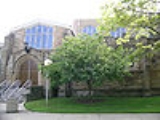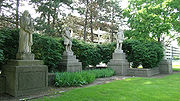
Saint Andrew's Memorial Episcopal Church
Encyclopedia

Michigan
Michigan is a U.S. state located in the Great Lakes Region of the United States of America. The name Michigan is the French form of the Ojibwa word mishigamaa, meaning "large water" or "large lake"....
. As of 2008, it is used by Wayne State University
Wayne State University
Wayne State University is a public research university located in Detroit, Michigan, United States, in the city's Midtown Cultural Center Historic District. Founded in 1868, WSU consists of 13 schools and colleges offering more than 400 major subject areas to over 32,000 graduate and...
and referred to as St. Andrew's Hall; street layout changes have re-indexed the address to 918 Ludington Mall. The church was listed on the National Register of Historic Places
National Register of Historic Places
The National Register of Historic Places is the United States government's official list of districts, sites, buildings, structures, and objects deemed worthy of preservation...
in 1986.
History
St. Andrew's parish, founded in 1885, was one of the earliest religious institutions established in what is now the University-Cultural Center section of Detroit. By January 1886, the parish had constructed a church at the corner of fourth and Putnam. In the early 1890s, plans for the present church were drawn up in by the Boston-based architectural firm of Cram, Wentworth & GoodhueRalph Adams Cram
Ralph Adams Cram FAIA, , was a prolific and influential American architect of collegiate and ecclesiastical buildings, often in the Gothic style. Cram & Ferguson and Cram, Goodhue & Ferguson are partnerships in which he worked.-Early life:Cram was born on December 16, 1863 at Hampton Falls, New...
. There was some delay in construction, but the church was completed in 1902.
In 1906, the church burned due to an electrical fire; it was repaired six years later, although the reconstruction did not restore the original design and has been criticized as architecturally disfiguring. It served the Episcopalian parish for a number of years until, after World War II
World War II
World War II, or the Second World War , was a global conflict lasting from 1939 to 1945, involving most of the world's nations—including all of the great powers—eventually forming two opposing military alliances: the Allies and the Axis...
, the surrounding population began an exodus to the suburbs. In 1961, the diocese leased the building to Wayne State University
Wayne State University
Wayne State University is a public research university located in Detroit, Michigan, United States, in the city's Midtown Cultural Center Historic District. Founded in 1868, WSU consists of 13 schools and colleges offering more than 400 major subject areas to over 32,000 graduate and...
for 99 years. The University uses it as a student chapel and a concert hall.
Description
St. Andrew's displays the straight, vertical and horizontal lines characteristic of Ralph Adams CramRalph Adams Cram
Ralph Adams Cram FAIA, , was a prolific and influential American architect of collegiate and ecclesiastical buildings, often in the Gothic style. Cram & Ferguson and Cram, Goodhue & Ferguson are partnerships in which he worked.-Early life:Cram was born on December 16, 1863 at Hampton Falls, New...
's work. The exterior is constructed of Bedford limestone, with Berea sandstone trimmings and minimal decorative stonework. Rows of massive columns grace the nave, and an enormous window is inset behind the altar.

